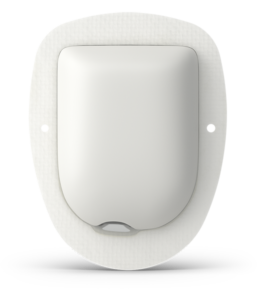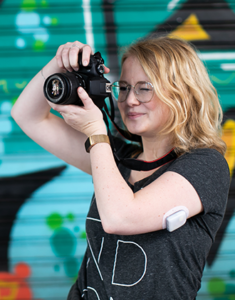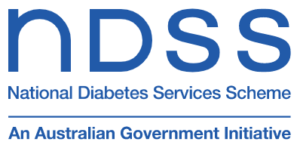Yes, the Omnipod DASH is soon to be subsidised through NDSS. People have been asking for this for a while (pretty much since the pods were introduced a year ago).
The new subsidy will apparently become effective on the 1st of December. Hopefully this means that the appropriate registration forms can be processed and training completed before December so people are ready to go on that day if they want.
Some introduction of the system first. Not all the subsidy options (outlined further below) will be available to everyone, and I think there are important issues here which give context.
An overview of the pods
 I’ve written about the pods a few times on this site, and they of course have their own section on the Insulin Pump Choices page. The Omnipod DASH system is manufactured by Insulet. They trade as both Insulet Corporation and Omnipod Australia, so you will see references to both names.
I’ve written about the pods a few times on this site, and they of course have their own section on the Insulin Pump Choices page. The Omnipod DASH system is manufactured by Insulet. They trade as both Insulet Corporation and Omnipod Australia, so you will see references to both names.
The pods get filled with 85-200 U of insulin and then stuck on your body. On command they insert a tiny (6.5mm at an angle) cannula and then last for 3 days. Actually they will run for up to 80 hours (but then cut off with a loud ongoing scream). So you need to fill them with enough (but not too much) insulin to last the stretch. People who use more than 60 U per day may find they can’t run them to the full length.
If you have to (or accidentally) remove the pod, you need to replace it with a new one. I find them reasonably “chunky” devices attached to my skin, but they’re rated as being waterproof for swimming.
As well as officially being used with their “PDM” handset, the DASH pods can instead be used with several opensource AID (closed loop) systems such as AndroidAPS, Loop, and FreeAPS X. As someone who has used these systems for years, I like being able to switch the pump component of the system to a DASH pod without having to change my entire diabetes management regimen.
Different types of “podders”
 Some people use the Omnipods full-time. Obviously these people will rejoice at the savings they may get with the new subsidy.
Some people use the Omnipods full-time. Obviously these people will rejoice at the savings they may get with the new subsidy.
Some people use them intermittently. This can be because they want to experiment with the system before committing to it (very important as it won’t suit everyone). Sometimes it’s because they like the different advantages of different pumps for different scenarios. I know of some kids who use them only on weekends or sports days (or vice versa), otherwise switching back to their regular pump.
Sometimes it’s been due to costs, and this NDSS announcement may change that.
Personally I’ve been in the camp of only using pods every now and then. I appreciate the waterproofness of them for when I’m engaging in watersports, but so far I’m usually more comfortable using my regular pump. So I have an open box of pods which I’ll gradually use over many months before they expire.
Some pod-specific issues for me have included:
- Need to replace the whole pod (instead of just an infusion site) if I need to move the site for any reason.
- Inflexibility about filling pods and the replacement cycle. With my regular pump I change my site every 3 days (with flexibility if I’m going to be asleep or busy at the time) but replace my reservoir when it’s empty (usually 4-5 days at the moment).
- Infusion reliability with the tiny cannula. On my last pod my insulin absorption went weird over the last day, and when eventually I took the pod off I found a mess under there. These things can happen with all pumps, but I find the regular tubed sites easier to manage and replace (see above). I’m now experimenting with some different infusion sets for my pump to see if it helps with Fiasp’s absorption, but I cannot do that with a pod.
- Interactions between choices of body location and Bluetooth reliability (as mentioned in a recent article).
One of the marketing points is that the pods are “tubeless”: no tubing to get tangled up and separate pump to carry around. I find this to be a minimal advantage: my regular pump lives in a running belt at my waist (under my clothes) that hides most of the tubing. Some people find the pods “life-changing” though.
Not a regular pump – not the same subsidy
 With traditional insulin pumps, NDSS provides subsidised access to pump consumables, and usually health insurers pay for the pumps (hopefully every 4 years after the warranty expires). The Insulin Pump Consumables (IPC) are basically the reservoirs and infusion sets.
With traditional insulin pumps, NDSS provides subsidised access to pump consumables, and usually health insurers pay for the pumps (hopefully every 4 years after the warranty expires). The Insulin Pump Consumables (IPC) are basically the reservoirs and infusion sets.
The NDSS IPC registration doesn’t specify which pump you use, which makes it possible to swap between pump systems. For example you may have your old pump of a different brand in the cupboard as a backup, and you can buy supplies for both. This isn’t going to work the same way with Omnipods.
Different ways of accessing (and paying for) pods
As far as I can see there will be three ways of accessing the pods.
You do need to be registered as a trained user of Omnipods to access them via all of these methods, usually involving training by a DE. That’s going to apply across all these methods. I believe quite a few people have been trained up already (some were enticed by the special offer earlier in the year where the first box of 10 pods was only $30).
Method 1 – No subsidy
This is the setup we have now. A box of 10 pods (ideally 30 days worth) can be bought for $420. There’s a slight saving as you go to more boxes at once, but it’s basically around $40 per pod. In 2022 there were special 4-for-2 offers to make them a bit cheaper, but I don’t think we’ll see those again.
I’m told that (as long as you’re a registered Omnipod user) this option will still be available, so anyone will be able to continue to buy pods.
I think many of the impending discussions of the subsidy will forget to mention this option though. As you’ll see below, it’s still relevant.
Method 2 – Register as an NDSS pod user
You will need to register with NDSS as a pod user (you need to be Omnipod-trained to get this). This also needs Insulet to certify your status as eligible to access subsidised pods. To maintain this status will currently cost $168.27 per month.
2a – Private Health Insurance
Private Health insurers will cover this, although probably only if you’re eligible for a new insulin pump through the insurer. Thus if you’re going to get health insurance to cover that overhead, it’s presumably a case of switching away from your old pump to the Omnipods.
Of course you may still have your tubed pump you’re happy using, but it probably won’t have warranty.
I don’t know that the insurers would make the payment monthly: I suspect they would pay most of it up-front. This would make it as difficult to change to a different pump system early as it is with other pumps.
2b – Private payment
If you can’t get your insurer to cover the cost, you can pay the $168.27 / month (directly to Omnipod Australia). Note that over 4 years (the standard term for pump warranties) this comes to just over $8000. That’s approximately the cost of most regular insulin pumps.
Of course this arrangement would allow you to have an in-warranty tubed pump at the same time. This may suit some people to tide them over until they’re next eligible for a pump through their insurer.
Apparently the minimum period for subscribing and thus getting subsidised pods may be 3 months.
As long as you meet three criteria:
- Registered with NDSS as having Type 1 Diabetes.
- Registered as a trained Omnipod user. This does not expire.
- Currently registered as eligible for subsidy (paid either by you or your insurer).
Then you’ll be able to order boxes of pods through your regular NDSS Access Point. A box of 10 pods will cost $29.30 for most people, and $22.20 if you have concession status.
Obviously if your eligibility status changes (e.g. no longer paying the monthly fee) then your ability to order pods through NDSS will cease. You will of course still be able to buy boxes directly from Insulet.
Quotas
It is not clear yet what the quota on NDSS purchases will be. Presumably you will be able to buy more than one box at a time so you can have a buffer with you, but as with all the other NDSS consumables there are limits on how many you can access (so far depending on the category the quota’s been over 6 or 12 months).
You would of course report any failed pods directly to Insulet and get them to replace them under warranty. You should not use up your allowance (and your and the government’s money) to replace failed pods. This is the same as with all the other NDSS-subsidised pump consumables, CGMs, etc.
Roll on December
That seems to be the guts of the new pod subsidy scheme. Either:
- Get your insurer to fund “a new pump” for you and make it the Omnipod system, and pay around $30 to NDSS for each month’s pods.
- Pay almost $200 a month (ongoing) for pods through NDSS.
- Pay $420 for an ad-hoc box of 10 pods (a month’s worth) directly to Insulet every now and then.
Another option may be possible too:
- Pay for 3 months of subsidised access, and end up with 30 pods for $592.71 (3 months of $168.27 and $29.30).
That would be cheaper than 3 boxes at $420 each.
Either way, I think more options are good!

Thanks for the update! I’m a current Podder who finds this truely life changing for my active T1D lifestyle!
I knew you’d be onto this one quickly!
When I first read the news about this while eating breakfast this morning, I though that this would be a great opportunity to try out the pods and maybe become a some time user, e.g. for beach holidays and other water activities. With my insulin requirements, I’d need to change pods every 2 days, so I can’t see that they’d be a viable long-term option. However, neither the online news reports nor the Minister’s press release appear to mention anythong about the monthly certification requirement.
So, Insulet gets to charge nearly $170/month to the patient (or their health insurer) for the benefit of keeing their status active; an activity which must cost Insulet somehere in the region of a few cents? Literally money for mothing! This is on top of the increased turnover that they will benefit from (although, presumably, on a reduced margin – but I’m sure they will cancel each other outto deliver substantially greater profits). This seems to be the ultimate example (maybe the definition?) of a rort and I, for one, will not support nor pay it. I’m appalled that any government would agree to this.
It’s a similar amount you pay to a pump manufacturer (just spread over 4 years).
Most of which provides warranty and support, and not just the pump itself. Do you find yourself thinking that (which is comparable) a rort too?
By the way Anthony the other pump manufacturers also receive money from the government for all the infusion sets/etc we buy. The government’s paying around 90% of the cost for us.
Option 2b seems interesting. I currently don’t have PHI & a 3 full boxes of pods. So when they are running low, making a payment of $168.27 then ordering a few boxes. Cancelling. Would work well. But the ability to do this is the question ….
I wonder if there is a private health insurance available which costs less than $168/month which covers a pump…
There is definitely private health insurance available that allows access to Pumps, for less than the $168 per month. I believe Medibank have one that is around $86 per month. Have a look at this website that shows some covers (not all though) https://www.finder.com.au/insulin-pumps-diabetes-and-health-insurance
Will they get rid of the 12 month waiting period for the Omnipod?
I would be surprised if they did. But that’s a question to ask both Insulet and your insurer.
After reading all your comments I feel it all sounds so complicated. I just use a Dexcom 6 sensor with no pump just insulin pens. It’s so simple. It’s $32.00 a box of three sensors that last 10 days each one. Just a quick jab and it’s over before I eat. Sometimes the old way can be simpler. I’m not saying my sugars are perfect as I have my ups and downs and corrections. I did try a pump a long time ago but didn’t like being attached to it all.
The omnipod sounds interesting but quite large and I am a very small dose.